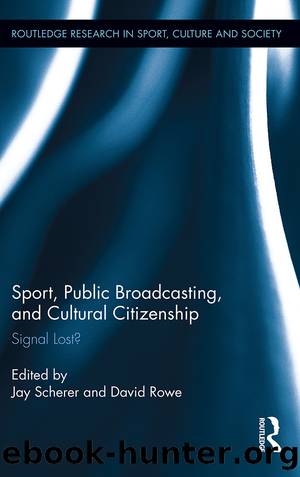Sport, Public Broadcasting, and Cultural Citizenship by Jay Scherer David Rowe

Author:Jay Scherer, David Rowe [Jay Scherer, David Rowe]
Language: eng
Format: epub
ISBN: 9781135017095
Barnesnoble:
Publisher: Taylor & Francis
Published: 2013-08-15T00:00:00+00:00
9 âEvents of National Importance and Cultural Significanceâ
Sport, Television, and the Anti-Siphoning Regime in Australia
David Rowe
Introduction: An Antipodean Paradise of Sport?1
It has often been claimed that Australia is a country that has an especially close and enduring attachment to sport. In Richard Cashmanâs (2010) eponymous book title, Australia has been perceived as a âParadise of Sport,â while Daryl Adair and Wray Vamplew (1997, p. ix) open their book Sport in Australian History with the proposition that âSport has long been a central feature of Australian popular cultureâso much so that enthusiasm for sport has been described widely as characteristic of being Australian.â Whether such typifications of Australia can be sustained by comparative international empirical evidence is not of specific concern here, nor are the causes (variously ascribed, separately and in combination, to convict and colonial history, masculinity, climate, and cultural isolationâsee, for example, Stoddart 1986). What can be ascertained, the subject of this chapter and book, is that there is no developed television sport environment in the world that is more heavily protected than Australia. The reason for this arrangement is, primarily, a combination of two forces: the power of the popular demand to maintain premium sport on free-to-air television and the political influence of the commercial terrestrial television sector, especially of the Nine Network (which routinely claims to be the most important sport broadcaster) and, in particular, of its most powerful figure, the late Kerry Packer (who died in December 2005).
Packer achieved international renown in international sport television when, in 1977, frustrated by the hold of the Australian Broadcasting Commission (ABC, the national public broadcaster now named the Australian Broadcasting Corporation) on its major summer sport, cricket, and by the ABCâs close relationship with the Australian Cricket Board (ACB), he established and broadcast a rival competition, World Series Cricket (WSC), after recruiting most of the worldâs best players (Barnett 1990, pp. 144â147, Goldlust 1987, pp. 161â164). Packer soon won the struggle, with the ACB capitulating to his demand to televise cricket, and to several of the sometimes-controversial innovations of WSC, such as night matches, colored clothing and various television viewing enhancements in camera, sound and editing technologies and practices. The ABC did continue to provide some television sport but, like most public service broadcasters around the world, it became a diminishing force as commercial television used its superior capital resources to win premium broadcast sport rights (Rowe 2000).
In other countries, including those with a strong public service broadcasting tradition, though, a second wave of commercialization of sport television occurred with the inception of subscription television (Boyle and Haynes 2009). In national environments with historically weak public broadcasting sectors, notably the US, subscription (cable and satellite) developed early, but there was some resistance in, for example, the UK, continental Europe, and East Asia to the idea that television should be paid for by viewers. But subscription television broke through, with sport television in particular proving to be the âbattering ramâ to the new televisual and associated services, in the often-quoted words of the major media figure Rupert Murdoch (Rowe 2004, p.
Download
This site does not store any files on its server. We only index and link to content provided by other sites. Please contact the content providers to delete copyright contents if any and email us, we'll remove relevant links or contents immediately.
Life 3.0: Being Human in the Age of Artificial Intelligence by Tegmark Max(5193)
The Sports Rules Book by Human Kinetics(4079)
The Age of Surveillance Capitalism by Shoshana Zuboff(3993)
ACT Math For Dummies by Zegarelli Mark(3855)
Blood, Sweat, and Pixels by Jason Schreier(3498)
Unlabel: Selling You Without Selling Out by Marc Ecko(3474)
Hidden Persuasion: 33 psychological influence techniques in advertising by Marc Andrews & Matthijs van Leeuwen & Rick van Baaren(3302)
Urban Outlaw by Magnus Walker(3246)
The Pixar Touch by David A. Price(3220)
Bad Pharma by Ben Goldacre(3102)
Project Animal Farm: An Accidental Journey into the Secret World of Farming and the Truth About Our Food by Sonia Faruqi(3019)
Brotopia by Emily Chang(2899)
Kitchen confidential by Anthony Bourdain(2835)
Slugfest by Reed Tucker(2807)
The Content Trap by Bharat Anand(2781)
The Airbnb Story by Leigh Gallagher(2707)
Coffee for One by KJ Fallon(2424)
Smuggler's Cove: Exotic Cocktails, Rum, and the Cult of Tiki by Martin Cate & Rebecca Cate(2341)
Beer is proof God loves us by Charles W. Bamforth(2253)
